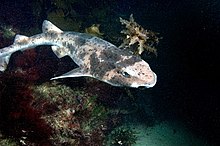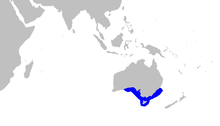
Back Cephaloscyllium laticeps Bulgarian Gató botit australià Catalan Cephaloscyllium laticeps CEB Cephaloscyllium laticeps Spanish Cephaloscyllium laticeps Basque Cephaloscyllium laticeps French Australische zwelhaai Dutch Австралийская головастая акула Russian Cephaloscyllium laticeps Swedish Головаста акула австралійська Ukrainian
| Australian swellshark | |
|---|---|

| |
| Scientific classification | |
| Domain: | Eukaryota |
| Kingdom: | Animalia |
| Phylum: | Chordata |
| Class: | Chondrichthyes |
| Subclass: | Elasmobranchii |
| Subdivision: | Selachimorpha |
| Order: | Carcharhiniformes |
| Family: | Scyliorhinidae |
| Genus: | Cephaloscyllium |
| Species: | C. laticeps
|
| Binomial name | |
| Cephaloscyllium laticeps (A. H. A. Duméril, 1853)
| |

| |
| Range of the Australian swellshark | |
| Synonyms | |
|
Cephaloscyllium nascione Whitley, 1932 | |
The Australian swellshark (Cephaloscyllium laticeps) or draughtboard shark, is a species of catshark, and part of the family Scyliorhinidae, endemic to southern Australia. This bottom-dwelling species can be found on the continental shelf down to a depth of 220 m (720 ft). Usually measuring 1 m (3 ft 3 in) long, it is a stout-bodied, broad-headed shark with a short tail and a first dorsal fin much larger than the second. It can be identified by its variegated dorsal coloration of brown or grey patches and numerous spots.
Australian swellsharks are sedentary and mainly nocturnal, with most individuals remaining within the same local area throughout the year. It feeds on small crustaceans, cephalopods, and fish. When threatened, it responds by rapidly taking in water or air to inflate its body, hence the name "swellshark". This shark is oviparous and females lay pairs of distinctively ridged egg capsules at 20- to 30-day intervals. The eggs hatch after 11–12 months. Harmless and of little commercial interest, many Australian swellsharks are caught incidentally in gillnets and bottom trawls but usually survive to be released because of their extreme hardiness. As a result, the International Union for Conservation of Nature (IUCN) has assessed this species as of Least Concern.
- ^ Walker, T.I.; White, W.T. (2016). "Cephaloscyllium laticeps". IUCN Red List of Threatened Species. 2016: e.T41753A68616196. doi:10.2305/IUCN.UK.2016-1.RLTS.T41753A68616196.en. Retrieved 12 November 2021.
© MMXXIII Rich X Search. We shall prevail. All rights reserved. Rich X Search
